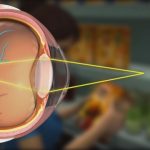Amblyopia is a very special term in the field of Ophthalmology/Optometry, which defines a condition that is vision loss in one eye or both the eyes, it is also known as lazy eye. Usually, the patient diagnoses with refractive errors in one and both the eyes and the vision of the eye/eyes are not restored even after giving the refractive correction. Random research shows that the developing period of amblyopia is first six months of life and it does not develop after the age of six years. According to the clinical evidence, the amblyopia can be divided in the following types,
- Anisometropic Amblyopia: Anisometropia is the term which defines a difference of +-1.00D of refractive error between the two eyes. And also, the most common cause of amblyopia is Anisometropia, several clinical studies shows that a patient with anisometropia has a very common tendency to develop Amblyopia. If the patient is not diagnosed with anisometropia in a very early age most of the time it is shown that the patient is also developed amblyopia.
- Ametropic Amblyopia: Not only in the case of amblyopia a patient with a same amount of refractive error in the both eyes (usually in high ametropia) are also having a tendency to develop amblyopia. Mostly a patient with a bilateral hypermetropia have a very common tendency to develop amblyopia.
- Strabismic Amblyopia: A patient with a squinting eye also have a very common tendency to develop Amblyopia. As the squinting eye became more suppressed and became lazy.
- Stimulus deprivation amblyopia: This kind of amblyopia develops due to nonuse of one eye from very early childhood. If the child born with a congenital media opacity like corneal opacity, cataract. The same condition can also develop due to presence of ptosis.
Apart from all this process amblyopia can be also clinically diagnose by another way and that is called.
- Toxic amblyopia: If one or both the eyes’ losses some amount of Vision permanently, due to any kind of ocular trauma or chemical injuries.
The diagnosis process of amblyopia in a clinic is not a very easy process as amblyopia does not shows any significant symptoms. So, it is necessary for every child to go for a comprehensive eye and vision examination at a very early stage of life. Now here we are going to describe the process of diagnosis of amblyopia.
- Vision screening: As Amblyopia does not show any significance symptoms by which the parents can get an idea weather their child is amblyopic or not. So primarily vision screening is the only procedure by which we can get an idea. If there is a huge difference between the distance visual acuity of the eyes primarily, we can suspect the child as amblyopic. And after that we have to go for refraction and if the vision of any eye is developing after giving the refractive correction by this way, we can diagnose it as a case of amblyopia.
- Refraction: After the vision screening there is another important aspect to detect amblyopia is the refraction. Usually, a patient with an anisometropia is primarily suspect as amblyopic. And if the vision of the one eye or both the eyes are not developing after giving the refractive correction then we can diagnose this case as amblyopia. Several clinical research shows that amblyopia is more common in case of hypermetropia than myopia.
- Misaligned or squinting eye: A misaligned or a squinting eye have always a very common tendency to develop amblyopia as the result of suppression of one eye. The parents must go for an immediate eye examination if the observed any kind of misalignment between both the eyes.
- Color Vision: Usually the color vision unaffected in case of amblyopia.
Clinical Evaluation and Prescription for amblyopia: Optometrist as a most important clinical personality in the ocular system. We need to mention all the possible clinical findings in the prescription and also need maintain the records about every single time the patients visit in the clinic. They are like the,
- Visual acuity (Both un aided and with refractive correction and pinhole).
Refraction (Both the cycloplegic refraction and the acceptance power of the patient).








